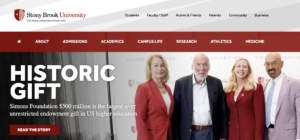When I reflect on my four years at college, would I do it over again? Yes. Why? I had a gut feeling it was where I belonged; I felt comfortable on campus. I believed I could flourish in that environment. Additionally, I had a lot of social support and academic support, and I benefitted from numerous scholarships that funded my education. I lived worry-free for a time.
When I was in college, I majored in Biology with a 3.6 GPA, was in 8 honor societies, did brain cancer research, and met my first love and professional relationships that would stand the test of time. Whether it's summer camp or school at any level you're considering, this post is for you especially if you've made it to the end of the article.
Recently, a colleague asked me how I find this type of support in the school as it's not on the website. To find academic support, I looked on the school's website to find the academics tab on their website. My school had it and then within that tab, there was a tab called academic resources. Under the academics tab, I searched for anything that could be useful for me to achieve my goal of academic prowess.
To find social support, I did a similar thing. My school had a tab called "campus life." I looked under this tab to see if there were any things or resources that appealed to me or could find most useful to me. Essentially, I explored the tabs on the school's website to see if I liked what it offered me and brainstormed briefly how it can help me make the most of my time there. There were many social clubs I could participate in at Stony Brook.
To find financial resources, most of them I applied before accepting my admissions decision to the school of my choice. I received over 20 scholarship endowments to support my educational journey. Prior to applying to college, my high school counselor had provided me with a list of scholarships to apply for. Nowadays, you can find other schools' recommended scholarship lists to apply for on Google.

Stony Brook, my alma mater, also awarded me financial scholarships to offset the cost of my education. I applied for Pell and TAP and any financial aid and got those as well. It meant that half of my tuition was paid by scholarships. While in college, I budgeted my meal plan points to ensure I spent what I had and not more.
When I got paid to do research, the position paid for my room & board on campus and food.
How do I know if my college has research opportunities? I perused Stony Brook's website once again to find research. Additionally, word-of-mouth insights were very powerful for me. I learned lots of things on school tours before applying to a school I wanted to attend. Then, backed it up with my own research when I was already in school.
I would also recommend searching to see if the school publicizes when it receives large monetary gifts. If it does, you will know it likely grants some of its funds for students and/or have abundant quality resources available to students. Stony Brook offered me both prior to accepting my admissions offer. At Stony Brook University, I had free quality tutoring available in any subject area that was challenging to me and professors were happy to help during office hours. Professors would answer any questions I had after class and during office hours.
To this day, because I excelled in my classes, one of my favorite professors created a job for me to graduate on time and I've been close with him and his family for over 10 years. He still writes me letters for jobs and higher education programs.
Going the distance before applying to a school you're interested in, search for social, financial, and academic support beforehand if you have time can save you a lot of time and money in the long run. Visit the school and tour it.

